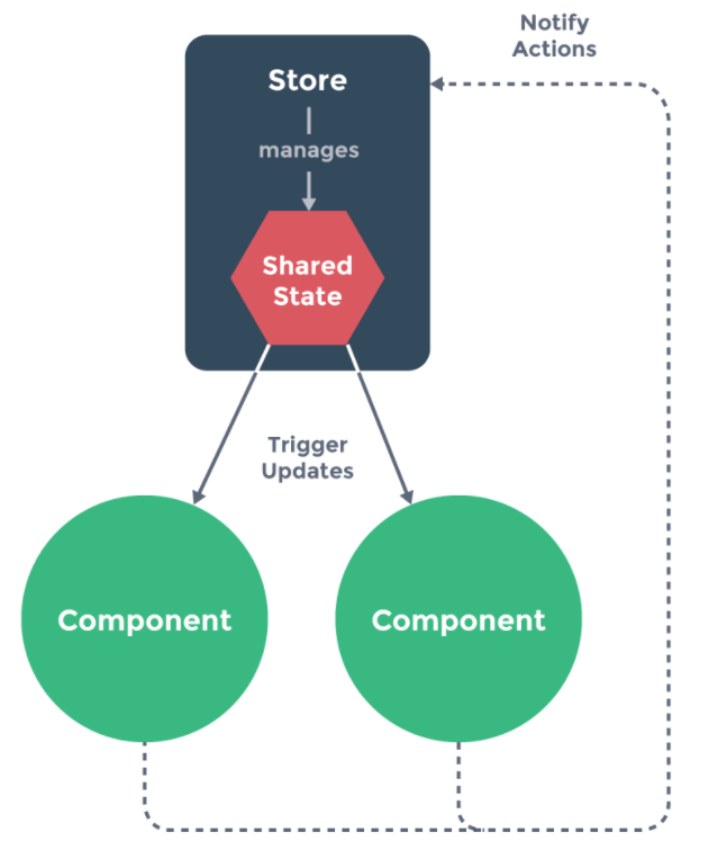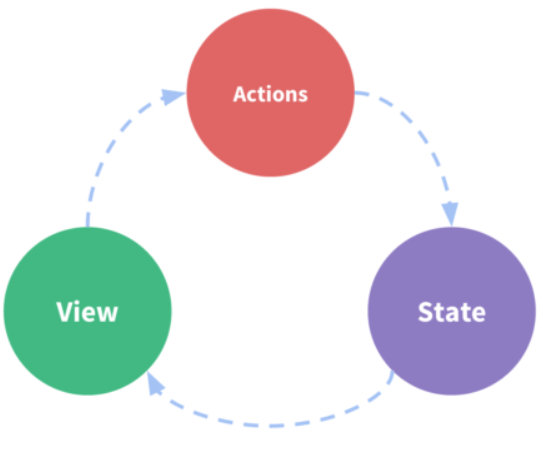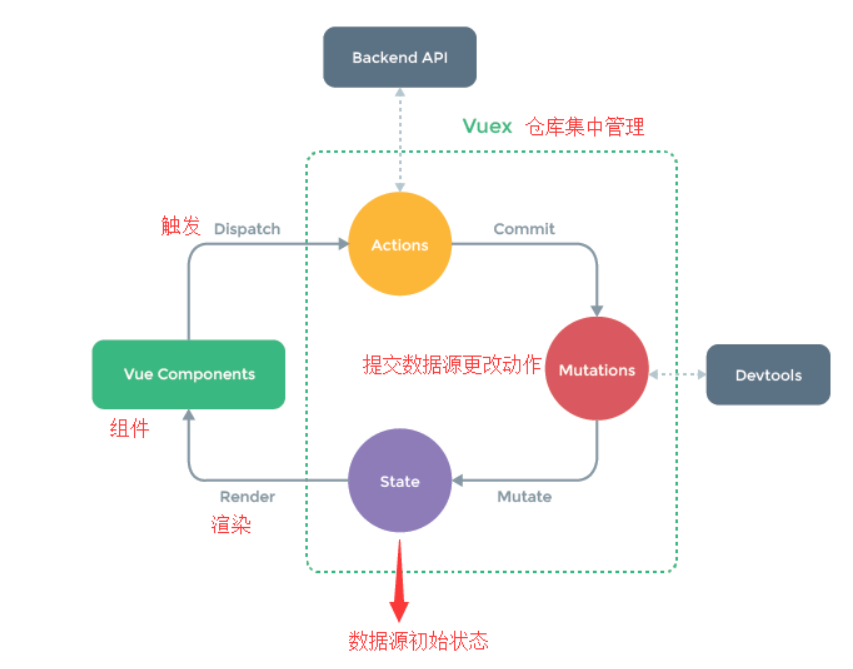vuex概念
vuex是一个专为 Vue.js 应用程序开发的状态管理模式。它采用集中式存储管理应用的所有组件的状态,并以相应的规则保证状态以一种可预测的方式发生变化。chrome安装调试工具 devtools extension
为什么要vuex
如果已经学过React 可以跳过这里,因为这个跟redux基本一样的
如果有代码基础,Vuex也可以理解为java中的一个map,这个map是static(静态资源)的,每次获取map的值,都需要调用java的api,比如map.get(key)获取对应的值,也可以放入数据map.put(data),而且这个数据是所有类都可以调用的,只需要导入这个map就能使用里面的共享数据。
当访问数据对象时,一个 Vue 实例只是简单的代理访问。所以,如果有一处需要被多个实例间共享的状态,可以简单地通过维护一份数据来实现共享
const sourceOfTruth = {}
const vmA = new Vue({
data: sourceOfTruth
})
const vmB = new Vue({
data: sourceOfTruth
}) 现在当 sourceOfTruth 发生变化,vmA 和 vmB 都将自动的更新引用它们的视图。子组件们的每个实例也会通过 this.$root.$data 去访问。现在有了唯一的实际来源,但是,调试将会变为噩梦。任何时间,应用中的任何部分,在任何数据改变后,都不会留下变更过的记录。
为了解决这个问题,采用一个简单的 store 模式:
var store = {
debug: true,
state: {
message: 'Hello!'
},
setMessageAction (newValue) {
if (this.debug) console.log('setMessageAction triggered with', newValue)
this.state.message = newValue
},
clearMessageAction () {
if (this.debug) console.log('clearMessageAction triggered')
this.state.message = ''
}
}所有 store 中 state 的改变,都放置在 store 自身的 action 中去管理。这种集中式状态管理能够被更容易地理解哪种类型的 mutation 将会发生,以及它们是如何被触发。当错误出现时,现在也会有一个 log 记录 bug 之前发生了什么
此外,每个实例/组件仍然可以拥有和管理自己的私有状态:
var vmA = new Vue({
data: {
privateState: {},
sharedState: store.state
}
})
var vmB = new Vue({
data: {
privateState: {},
sharedState: store.state
}
})
组件不允许直接修改属于 store 实例的 state,而应执行 action 来分发 (dispatch) 事件通知 store 去改变,最终达成了 Flux 架构。这样约定的好处是,能够记录所有 store 中发生的 state 改变,同时实现能做到记录变更 (mutation)、保存状态快照、历史回滚/时光旅行的先进的调试工具
所以这里就可以基本理解为什么要store,为什么要Vuex了吧
什么状态需要Vuex去管理?
- 比如用户的登录的状态(token)、用户的信息(头像、名称、地理位置信息)等等
- 比如商品的收藏,购物车的商品等等
- 这些状态应该是响应式的,用户昵称、头像修改了需要响应
Vue的单向数据流

示意图说明:
- State:驱动应用的数据源(单向数据流)
- View:以声明方式将 state 映射到视图(静态显示出来的数据源)
- Actions:处理用户在view上面操作而导致的状态变化(数据源变化追踪)
vuex与全局变量的区别
- 响应式:vuex的状态存储是响应式的,当Vue组件从store中读取状态的时候,若store中的状态发生变化,那么相应的组件也会得到高效更新
- 不能直接改变store:不能直接改变store的变化,改变store中状态的唯一途径是commit mutation,方便于跟踪每一个状态的变化
这就是 Vuex 背后的基本思想,借鉴了 Flux、Redux、和 The Elm Architecture。与其他模式不同的是,Vuex 是专门为 Vue.js 设计的状态管理库,以利用 Vue.js 的细粒度数据响应机制来进行高效的状态更新
vuex核心流程

示意图说明:
- Vue Components:Vue组件。HTML页面上,负责接收用户操作等交互行为,执行dispatch方法触发对应action进行回应
- Dispatch:操作行为触发方法,是唯一能执行action的方法
- Actions:操作行为处理模块。负责处理Vue Components接收到的所有交互行为。包含同步/异步操作,支持多个同名方法,按照注册的顺序依次触发。向后台API请求的操作就在这个模块中进行,包括触发其他action以及提交mutation的操作。该模块提供了Promise的封装,以支持action的链式触发
- Commit:状态改变提交操作方法。对mutation进行提交,是唯一能执行mutation的方法
- Mutations:状态改变操作方法。是Vuex修改state的唯一推荐方法,其他修改方式在严格模式下将会报错。该方法只能进行同步操作,且方法名只能全局唯一。操作之中会有一些hook暴露出来,以进行state的监控等
- State:页面状态管理容器对象。集中存储Vue components中data对象的零散数据,全局唯一,以进行统一的状态管理。页面显示所需的数据从该对象中进行读取,利用Vue的细粒度数据响应机制来进行高效的状态更新
- Getters:state对象读取方法。图中没有单独列出该模块,应该被包含在了render中,Vue Components通过该方法读取全局state对象
安装
npm install vuex --save项目结构
Vuex 并不限制代码结构。但是,它规定了一些需要遵守的规则:
1、应用层级的状态应该集中到单个 store 对象中
2、提交 mutation 是更改状态的唯一方法,并且这个过程是同步的
3、异步逻辑都应该封装到 action 里面
只要遵守以上规则,可以随意组织代码。如果store文件太大,只需将 action、mutation 和 getter 分割到单独的文件
对于大型应用,希望把 Vuex 相关代码分割到模块中。下面是项目结构示例:
├── index.html
├── main.js
├── api
│ └── ... # 抽取出API请求
├── components
│ ├── App.vue
│ └── ...
└── store
├── index.js # 组装模块并导出 store 的地方
├── actions.js # 根级别的 action
├── mutations.js # 根级别的 mutation
└── modules
├── cart.js # 购物车模块
└── products.js # 产品模块实例操作
看下面之前,先想想计数器要是使用Vue怎么实现
然后看下面的基本语法,实现一个Vue的计数器
1.state-状态对象的获取方法(组件内)
在组件的template中直接使用
<h2>{{ $store.state.count }}</h2>由于 Vuex 的状态存储是响应式的,从 store 实例中读取状态最简单的方法就是在计算属性中返回某个状态
1、在计算属性computed中直接赋值
computed: {
count() {
// this指的是main.js中的vue实例对象
return this.$store.state.count;
}
}2、通过mapState的对象来赋值
mapState 函数返回的是一个对象
import { mapState } from 'vuex'
computed: mapState({
// es5写法
count: function (state) {
return state.count;
},
// es6写法
count: state => state.count,
// 想访问局部状态,就必须借助于一个普通函数,函数中使用 `this` 获取局部状态
countPlusLocalState (state) {
return state.count + this.localCount
}
})通过mapState的数组来赋值- 常用
import { mapState } from 'vuex'
// 映射 this.count 为 store.state.count
computed: mapState(['count'])通过mapState的JSON来赋值- 常用
import { mapState } from 'vuex'
computed: mapState({
count: 'count'
})3.store中的Getter函数 - store从state取数据
设置store中Getter,然后组件中直接取值
const store = new Vuex.Store({
state: {
todos: [
{ id: 1, text: '...', done: true },
{ id: 2, text: '...', done: false }
]
},
getters: {
doneTodos: state => {
return state.todos.filter(todo => todo.done)
}
}
})computed: {
...mapGetters([
'doneTodos',
'other'
])
}
//或者
computed: {
doneCount() {
return this.$store.getters['doneTodosCount']
}
}注意!!Getter 也可以接受其他 store中getter 作为第二个参数
getters: {
// ...
doneTodosCount: (state, getters) => {
return getters.doneTodos.length
}
}
store.getters.doneTodosCount // -> 12.mutations-getters-actions异步
mutations(修改状态)
无参数的基本版本
const store = new Vuex.Store({
state: {
count: 1
},
mutations: {
increment (state) {
// 变更状态
state.count++
}
}
})store.commit('increment')//调用提交载荷(Payload) - 有参数
mutations: {
increment (state, n) {
state.count += n
}
}
store.commit('increment', 10)在大多数情况下,载荷应该是一个对象
提交载荷(Payload) 带type
提交 mutation 的另一种方式是直接使用包含 type 属性的对象
store.commit({
type: 'increment',
amount: 10
})当使用对象风格的提交方式,整个对象都作为载荷传给 mutation 函数
mutations: {
increment (state, payload) {
state.count += payload.amount
}
}Mutation必须是同步函数
actions和mutations功能基本一样,不同点是,actions是异步的改变state状态,而mutations是同步改变状态。不过实际项目中一般都是通过actions改变mutations中的值。
在组件中提交Mutation - mapMutations
import { mapMutations } from 'vuex'
export default {
// ...
methods: {
...mapMutations([
'increment', // 将 `this.increment()` 映射为 `this.$store.commit('increment')`
// `mapMutations` 也支持载荷:
'incrementBy' // 将 `this.incrementBy(amount)` 映射为 `this.$store.commit('incrementBy', amount)`
]),
...mapMutations({
add: 'increment' // 将 `this.add()` 映射为 `this.$store.commit('increment')`
})
}
}严格模式
严格模式下,无论何时发生了状态变更且不是由 mutation 函数引起的,将会抛出错误。这能保证所有
的状态变更都能被调试工具跟踪到。开启严格模式 strict: true
3.action
基本特点
Action类似于mutation,不同之处在于:
1、Action 提交的是 mutation,而不是直接变更状态
2、Action 可以包含任意异步操作
基本的action写法
actions: {
increment ({ commit }) {
commit('increment')
}
}
store.dispatch('increment')乍一眼看上去感觉多此一举,直接分发 mutation 岂不更方便?实际上并非如此,mutation必须同步执行这个限制,而Action 就不受约束,可以在 action 内部执行异步操作
//实际上还是不一样哦
actions: {
incrementAsync ({ commit }) {
setTimeout(() => {
commit('increment')
}, 1000)
}
}载荷方式和对象方式进行分发
// 以载荷形式分发
store.dispatch('incrementAsync', {
amount: 10
})
// 以对象形式分发
store.dispatch({
type: 'incrementAsync',
amount: 10
})来看一个更加实际的购物车示例,涉及到调用异步 API 和分发多重 mutation
actions: {
checkout ({ commit, state }, products) {
// 把当前购物车的物品备份起来
const savedCartItems = [...state.cart.added]
// 发出结账请求,然后乐观地清空购物车
commit(types.CHECKOUT_REQUEST)
// 购物 API 接受一个成功回调和一个失败回调
shop.buyProducts(
products,
// 成功操作
() => commit(types.CHECKOUT_SUCCESS),
// 失败操作
() => commit(types.CHECKOUT_FAILURE, savedCartItems)
)
}
}在组件中分发Action - mapActions
import { mapActions } from 'vuex'
export default {
// ...
methods: {
...mapActions([
'increment', // 将 `this.increment()` 映射为 `this.$store.dispatch('increment')`
// `mapActions` 也支持载荷:
'incrementBy' // 将 `this.incrementBy(amount)` 映射为 `this.$store.dispatch('incrementBy', amount)`
]),
...mapActions({
add: 'increment' // 将 `this.add()` 映射为 `this.$store.dispatch('increment')`
})
}
}
//或者
import { mapActions } from 'vuex'
export default {
methods: {
increment(...args) {
return this.$store.dispatch.apply(this.$store, ['increment'].concat(args))
}
add(...args) {
return this.$store.dispatch.apply(this.$store, ['increment'].concat(args))
}
}
} 组合多个Action
Action 通常是异步的,那么多个action的时候怎么样才能保证action已经执行了呢
首先,需要明白 store.dispatch 可以处理被触发的 action 的处理函数返回的 Promise,并且 store.dispatch 仍旧返回 Promise
actions: {
actionA ({ commit }) {
return new Promise((resolve, reject) => {
setTimeout(() => {
commit('someMutation')
resolve()
}, 1000)
})
}
}现在可以
store.dispatch('actionA').then(() => {
// ...
})在另外一个 action 中也可以:
actions: {
// ...
actionB ({ dispatch, commit }) {
return dispatch('actionA').then(() => {
commit('someOtherMutation')
})
}
}最后,如果利用 async / await 这个 JavaScript 新特性,可以像这样组合 action
// 假设 getData() 和 getOtherData() 返回的是 Promise
actions: {
async actionA ({ commit }) {
commit('gotData', await getData())
},
async actionB ({ dispatch, commit }) {
await dispatch('actionA') // 等待 actionA 完成
commit('gotOtherData', await getOtherData())
}
}一个
store.dispatch在不同模块中可以触发多个 action 函数。在这种情况下,只有当所有触发函数完成后,返回的 Promise 才会执行
4.组件中执行命令
this.$store.dispatch('setWindowWidth', window.innerWidth);5.module-模块组
基本结构
// 模块A
const moduleA = {
state: { ... },
mutations: { ... },
actions: { ... },
getters: { ... }
}
// 模块B
const moduleB = {
state: { ... },
mutations: { ... },
actions: { ... }
}
// 组装
const store = new Vuex.Store({
modules: {
a: moduleA,
b: moduleB
}
})
// 取值
store.state.a // -> moduleA 的状态
store.state.b // -> moduleB 的状态模块的局部状态
对于模块内部的 mutation 和 getter,接收的第一个参数是模块的局部状态对象
const moduleA = {
state: { count: 0 },
mutations: {
increment (state) {
// 这里的 `state` 对象是模块的局部状态
state.count++
}
},
getters: {
doubleCount (state) {
return state.count * 2
}
}
}同样,对于模块内部的 action,局部状态通过 context.state 暴露出来,根节点状态则为 context.rootState:
const moduleA = {
// ...
actions: {
incrementIfOddOnRootSum ({ state, commit, rootState }) {
if ((state.count + rootState.count) % 2 === 1) {
commit('increment')
}
}
}
}对于模块内部的 getter,根节点状态会作为第三个参数暴露出来:
const moduleA = {
// ...
getters: {
sumWithRootCount (state, getters, rootState) {
return state.count + rootState.count
}
}
}这里的练习在github
6.命名空间&测试Mutation
这里我没做练习弄明白 嘿嘿 所以想了解请看命名空间
Vuex的API
辅助函数
mapState
mapState(namespace?: string, map: Array<string> | Object): Object为组件创建计算属性以返回 Vuex store 中的状态。第一个参数是可选的,可以是一个命名空间字符串
mapGetters
mapGetters(namespace?: string, map: Array<string> | Object): Object为组件创建计算属性以返回 getter 的返回值。第一个参数是可选的,可以是一个命名空间字符串
mapActions
mapActions(namespace?: string, map: Array<string> | Object): Object创建组件方法分发 action。第一个参数是可选的,可以是一个命名空间字符串
mapMutations
mapMutations(namespace?: string, map: Array<string> | Object): Object创建组件方法提交 mutation。第一个参数是可选的,可以是一个命名空间字符串
createNamespacedHelpers
createNamespacedHelpers(namespace: string): Object 创建基于命名空间的组件绑定辅助函数。其返回一个包含 mapState、mapGetters、mapActions 和 mapMutations 的对象。它们都已经绑定在了给定的命名空间上
实例方法
commit(type: string, payload?: any, options?: Object) | commit(mutation: Object, options?: Object) 提交 mutation。options 里可以有 root: true,它允许在命名空间模块里提交根的 mutation
dispatch(type: string, payload?: any, options?: Object) | dispatch(action: Object, options?: Object) 分发 action。options 里可以有 root: true,它允许在命名空间模块里分发根的 action。返回一个解析所有被触发的 action 处理器的 Promise
replaceState(state: Object)替换 store 的根状态,仅用状态合并或时光旅行调试
watch(getter: Function, cb: Function, options?: Object) 响应式地监测一个 getter 方法的返回值,当值改变时调用回调函数。getter 接收 store 的状态作为唯一参数。接收一个可选的对象参数表示 Vue 的 vm.$watch 方法的参数。
要停止监测,直接调用返回的处理函数
subscribe(handler: Function) 注册监听 store 的 mutation。handler 会在每个 mutation 完成后调用,接收 mutation 和经过 mutation 后的状态作为参数
store.subscribe((mutation, state) => {
console.log(mutation.type)
console.log(mutation.payload)
})通常用于插件
registerModule(path: string | Array<string>, module: Module)注册一个动态模块
unregisterModule(path: string | Array<string>)卸载一个动态模块
hotUpdate(newOptions: Object)热替换新的 action 和 mutation

